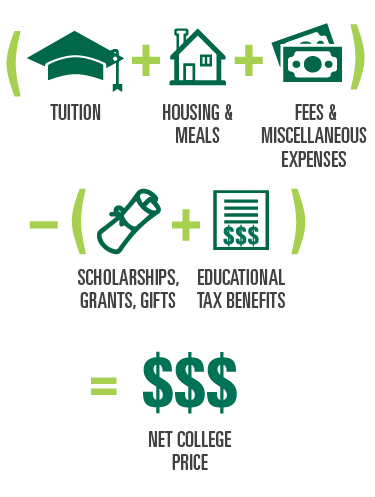For most students and their families, college cost remains one of the biggest factors in picking a school. In fact, recent research indicates the top reason students don’t attend their first-choice college is due to cost.
It’s true that over the past two decades, college costs have continued to rise. The good news is that students now have more tools and resources to decrease costs and avoid college debt. These resources include countless scholarships and grants, such as freshmen scholarships.
3 STEPS FOR DETERMINING THE COST OF COLLEGE
1. Understand the Difference Between Tuition and Cost
Unfortunately, most students don’t know how to accurately determine their actual college cost, so they get a skewed perception of their eventual out-of-pocket expenses. One of the biggest mistakes students make is to simply look at the sticker price, which includes the published tuition and fees. However, sticker price fails to take into account the various factors that can determine a school’s final cost.
Instead, encourage students to focus on the net price of attendance:

Once a student has this net price, they can accurately determine the amount they’ll have to pay or take out in loans to cover the cost. Several online tools can help, including the College Cost Calculator from the College Board.
USF COST OF ATTENDANCE: AFFORDABILITY + VALUE
USF combines low tuition with incredible student resources and amenities. In fact, we've been nationally recognized for our affordability and value by many outside organizations, including Kiplinger’s Personal Finance and U.S. News & World Report.
To get a detailed cost breakdown of attending USF, including tuition, housing, meals, books and more, visit our website.
2. Identify Less Obvious College Costs
Encourage students to explore and account for these less obvious expenses that can influence their final higher education costs. Even with identical tuition costs, two schools can vary widely in the final price. That’s because a college may include several additional fees, opportunities or expenses that can drive up cost:
- Out-of-State Tuition
- Travel Expenses
- Vehicle Costs
- Greek Life and Campus Clubs




3. Discover Potential College Discounts
Depending on the school, college cost may not be set in stone. Students should inquire with each college’s admissions office when deciding which school to attend to find out if they honor any special discounts:
- If a family member works at the school
- If the family’s main wage earner is unemployed
- Alumnus or alumna discount due to a parent attending
- Reduction due to more than one family member being enrolled
- Reduced cost for older students
Even if a student does not get a discount their freshman year, they could receive a break in their later years for experience as a student government leader or affiliation with the college newspaper or yearbook.

